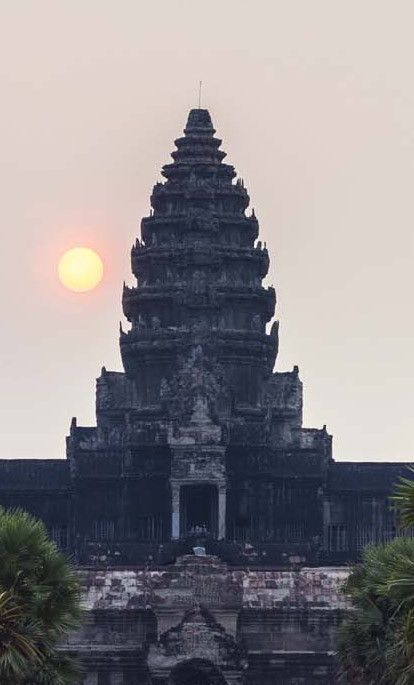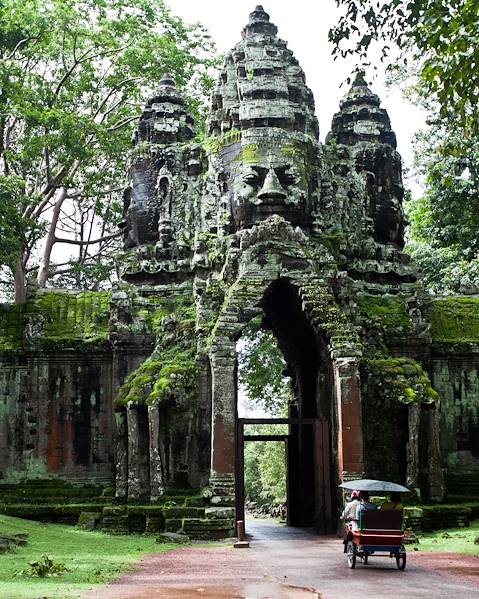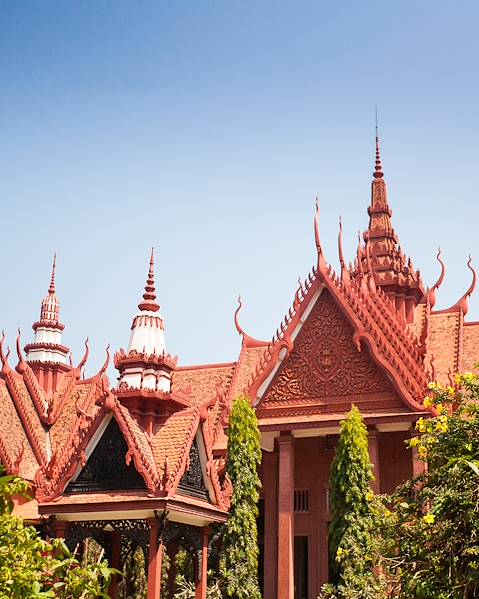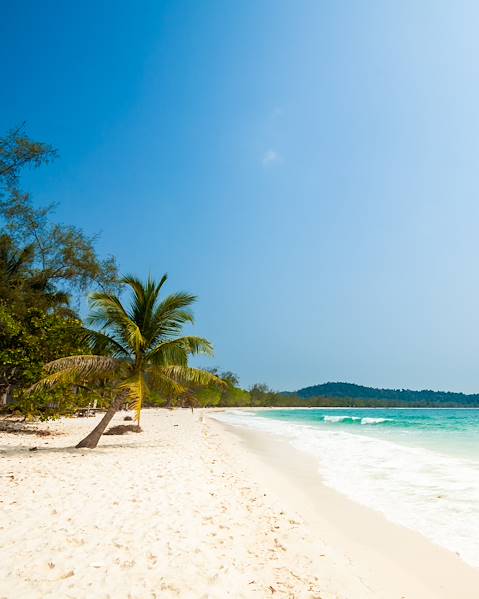Population
16,737,971 inhabitants (2019).
Official language
Khmer
Languages spoken
85% of Cambodians speak Khmer (a non-tonal language - which is rare in the region - with a written alphabet derived from the Pallava script of southern India). The key minority languages are Vietnamese, Cham and Chinese. French is the most widely used foreign language (15% of speakers), followed by English (5% speakers).
People
The Khmer represent 85.4% of Cambodians. Just 7.4% are Vietnamese; 3.5% are Cham; 3.2% Chinese; 0.2% are Kui; 0.2% are Mnong. The Khmer, Vietnamese and Chinese generally live in the Central Plains; Cham, Kui, the Mnong and other ancient people occupy the mountainous areas.
Religion
Theravada Buddhism is the majority religion. This is the ‘doctrine of the elders’ – one of the oldest existing schools of Buddhism, based on the Pali Canon - the standard collection of scriptures. In this tradition, there are no supernatural intercessors, bodhisattvas, and monasticism is the preferred way of living. Hinduism was one of the Khmer Empire’s official religions and Angkor reflects this – the holy temple of Angkor Wat is the largest Hindu temple in the world. The Cham are Muslim. Small Khmer and Vietnamese Catholic communities exist here and there are some minorities still practicing animist rituals.
National Holiday
November 9: Anniversary of Independence (1953).
Holiday Schedule
- January 1: New Year's Day.
- January 7: commemoration of the fall of the Khmer Rouge regime.
- January or February: celebration of Tet (Lunar New Year); this is an important holiday: shops and restaurants are closed for several days.
- April: Khmer New Year (three days of festivities).
- April 17: Victory Day (fall of the Lon Nol regime).
- In late April or early May: anniversary of the Buddha's Enlightenment.
- May 1: Labour Day.
- May 9: Day of Genocide (in memory of the victims of Khmer Rouge regime).
- May 11: Seeds of celebration. May 22: King's birthday.
- June 8: Birthday of Queen.
- September: Feast of the Ancestors.
- September 24: Constitution Day.
- October: end of Buddhist 'Lent' (offerings to the monks).
- 30 October - 1 November: Anniversary of Norodom Sihanouk.
- November: Water Festival.
- November 9: National Day.
- December 25: Christmas.
History
Around 3000 BC, people migrated from southern China to the south - the ancestors of the Khmer and Mon people, who moved between the Irrawaddy Delta and the Mekong. From the first century AD, the influence of India covered the region. A Mon kingdom (the Kingdom of Funan) appeared in the current Cambodia, experiencing a heyday in the fifth century. In the following century, Hindus Rouge (The Kingdom of Chen) superseded the sovereign Môn. In the seventh century, King Jayavarman 1 prevailed in the Angkor region. But a few decades later, Chen broke down and the Khmers were forced to accept the suzerainty of Java. In 802 AD, King Jayavarman II moved his capital to the north of the Tonle Sap and undertook water projects of great magnitude. This period saw the beginnings of the Hindu kingdom. Two new factors appeared quickly during this time: Buddhism and Ham, which would long be at odds with the Khmers. In the 12th century, Suryavarman II built Angkor Wat, dedicated to Vishnu. Yet it’s through the Buddhist king Jayavarman VII (1181-1227) that the empire had its greatest rule, and the new capital, Angkor Thom, was born. At the end of the 13th century, the Khmers were threatened by the Mongols; the Thais and Lao emancipated themselves, and the Hindu restore failed. In 1336 a Buddhist commoner ascended the throne, signalling the end of Classical Hindu empire. At this time, Siam was the power of the moment and it attacked and took Angkor (1351), then Rouge (1357), then Angkor Thom (1431). The Khmer ultimately accepted vassalage.
In the 14th century, Theravada Buddhism was brought over to Cambodia, preached by Sri Lankans. Khmer countries fell into decay. There was a brief period of prosperity in the 19th century under suzerainty of the Siamese. From the 17th century, the Vietnamese challenged the Siamese domination and began the colonization of the Mekong Delta. Siam was overlord, but Vietnam imposed a protectorate in 1771; Siam restored suzerainty four years later, but under Gia Long (1762-1820), Vietnam reimposed guardianship. The Khmer were largely back in the reign. Between 1834 and 1841, the new Taulier imposed a mandarin order to conquer it. In 1845, the Vietnamese were massacred, and Siam intervened. To avoid the final division, King Ang Duong appealed to France, though this failed. Eventually King Norodom 1 (1834-1904) signed a protectorate agreement with France in 1863. The capital was transferred from Udong to Phnom Penh. The reform program supported by Norodom first encountered the ‘nomenklatura’ Confucian. In 1904 and 1907, Siam restored the provinces of Battambang and Siem Reap. As part of the Indochinese Union, infrastructure works were incurred, but the country was lagging behind in regional development.
In 1940, Siam attacked Cambodia. The provinces recovered early during this century, and were again transferred, despite victorious Franco-Cambodian. Norodom Sihanouk came on the scene. Vichy administered until March 9, 1945, when the country was occupied by Japan. Sihanouk denounced protectorate. Khmer nationalism flourished again, which momentarily served Japanese interests. The return of the French saw hard independence (9 November 1953). Cambodia joined the Non-Aligned (Bandung Conference, 1955) and experienced a period of peace and development until the mid 1960s, but the country served as a logistical support point for the Viet Cong and was drawn into the Vietnam War. Sihanouk was overthrown on 18 March 1970 by General Lon Nol (1913-1985). The following month, American and South Vietnamese attacked Viet Cong bases in Cambodia. Lon Nol's forces were caught between the Vietnamese and Khmer Rouge guerrillas, who, in 1973, controlled 60% of the territory. While Sihanouk was in Beijing, April 17, 1975 saw the Khmer Rouge start the four years of Democratic Kampuchea nightmare. December 1978, the Vietnamese army swept between Cambodia and the Khmer Rouge and removed one of his cronies, Heng Samrin (born 1934), as head of a new People's Republic of Cambodia. In the late 1980s, a diverse coalition (Sihanouk to the Khmer Rouge), supported by the West, got the withdrawal of Vietnamese. The UN supported the reorganisation of the country (and resettlement). In 1993, a legislature was elected; Sihanouk found his throne; Hun Sen (born in 1952) consolidated his premiership chair. The Khmer Rouge kept a military offensive organization until 1998.
Policy
Cambodia is a constitutional monarchy; whose crown is not necessarily hereditary. The parliament has legislative power; it is two houses: the National Assembly (123 members elected for five years); the Senate (61 members, elected or appointed for five years). The Prime Minister, from the parliamentary majority, is appointed by the king. The laws passed by parliament must be approved by the monarch (though this is purely symbolic as he cannot really refuse). The Supreme Judicial Council is the highest court.
Famous Cambodians
- Former head of state, Norodom Sihanouk (born 1922) was a powerful Cambodian figure and played a lead role in many of the country’s key political movements. An enduring symbol of Cambodia, he was adored by the nation.
- Pol Pot (Saloth Sar, 1928-1998) – on the other hand - is a name synonymous with heinous crimes. A former student of the French School of radioelectricity in Paris, he was the leader of the Khmer Rouge who oversaw the Cambodia genocide. The political system he put in place after 1975 was a radical experiment, ultimately wiping out almost a quarter of the country’s population - 1.5 – 2 million people – in four years.
- Sinn Sisamouth (1935-1975) was a famous singer-songwriter from the 1950s to the 1970s who became something of a music icon in the Southeast Asian country, blending westernised rhythm and blues and rock and roll with traditional Khmer music. His death in 1976 remains a mystery and his body has never been found, having gone missing during the Khmer Rouge genocide.
- Preah Bat Ang Duong (1796-1860) was a King of Cambodia from 1841 to his death. Reigning during harsh political conditions, he began modernising the country (boosting trade and education) and focused on sustained national unity. He was also a respected poet and novelist.
- Son Ngoc Thanh (1908-1977) is a symbol of the Cambodian nationalism and was a republican politician with long periods of rebelling against the government; at other times he worked as prime minister under the rule of Sihanouk and Lon Nol. Having been exiled to Vietnam, Thanh was arrested and died in custody in Ho Chi Minh City in 1977.
Good manners
Tipping is at your discretion. For all those working with us, you have the assurance that your tips will never replace a salary. For drivers, we recommend the equivalent of £2 per person, per day. We recommend you double this amount for the guides. At hotels, it’s generally £1 for luggage carriers and for service. There are no hard and fast rules about how much to tip in restaurants. Generally, it is best to align your tip on the local economy: look at the price of a beer or of a tea and estimate based on that amount.
Do not encourage begging, especially with children, by handing out money and items in the street. If you want to help by providing school supplies, clothing or medicine, it is best to give them directly to the school principal, the village chief or the nearest clinic, which will to benefit the needy.
The Cambodian ‘sampeah’ is the traditional greeting or way of show respect by placing your palms in prayer-like pose and tilting your head forward in a bow. The deeper the bow and the higher the hands, the bigger the sign of respect. A handshake like in the western world is customary in commercial or administrative relationships for men and women. In public, people, should be referred to as ‘sir’ or ‘madam’. Akin to the rest of Asia, it’s customary to bring a small gift of gratitude when invited to someone’s house. It must be handed over in the right hand or both hands. Do not forget to remove your shoes before entering a Khmer home. Cambodians are generally very modest and this should be respected at all times: avoid going topless in public, for example. When visiting the renovated parts of Angkor Wat and Baphuon (Angkor Thom), knees and arms must be covered up (no short or tank tops).
The head is the most sacred part of the body - it is inappropriate to touch anyone’s head, even a child. Doing so is the equivalent of swearting at someone in Europe. And never photograph a person without their permission. We highly recommend going to a temple in the late afternoon, around 5pm during the monks’ hour of prayer. It's a mesmerising experience. However, do not make a sound and take your shoes off, being careful not to point feet directly towards the Buddha. Wear the correct sort of clothes, keeping arms and legs covered. Catching sight of the early morning offerings - Tak Bat - is also fascinating. Just before dawn, processions of saffron-robed monks collect offerings from the streets. It’s a serene experience: just ensure you remain silent, avoid contact with the monks and refrain from hindering the ceremony with obtrusive photography. If you’d like to participate with offerings, it is better to buy rice at the early morning market rather than from retailers near the procession. Never offer monks money – it is deemed highly disrespectful. Although fairly widespread, the electronic cigarette is officially banned in Cambodia.
Shopping
There are all sorts of interesting, crafty things to buy in the markets of Phnom Penh. There’s the Krama, for example - a checked cloth, that Cambodians wear as a scarf, a turban or a belt. It is traditionally red and white or blue and white, but the weavers today create them in a wide range of colours. The most beautiful kramas are cotton and silk (or solely silk) and come from Kampong Cham. There are also stalls of silver jewellery, wooden carvings, copper objects, paintings and statues of ancient prints, among many other items for sale. The Russian market is the one bazaar visitors should not miss out on in Phnom Penh, stacked with souvenirs and cut-price branded clothing. Be warned it is strictly forbidden to leave the country carrying Khmer antiquities. Refrain from taking pebbles picked up in temples or sculptures purchased from knock-off dealers: the customs officials at Siem Reap International Airport know exactly how to find these items.
Food
Cambodian cuisine has been influenced by several other nations: Thai, Lao, French and Indian. Rice is the staple food and meals are usually accompanied by a soup (samla). The ginger pork soup (samla Chapek) is particularly tasty. Cambodians eat a lot of fish, which gives them the Tonle Sap. Grilled fish is cut into pieces, wrapped in a lettuce leaf, or spinach, then soaked in a fermented fish sauce (or shrimp). The Khmer curries are characterised by the frequent use of coconut milk. The salads, flavoured with coriander, mint or lemon thyme, are fresh and light. Rice noodles can be bought on every street corner. There are all kinds of exotic fruits for sale, but one of the more interesting is the durian: known for its pungent smell, it has a silky texture and a unique flavour.
Drink
Avoid drinking tap water (and ice) and always go for bottled mineral water, ensuring the cap hasn’t been broken. There are plenty of fizzy drinks for sale and beer which is blonde and light: Angkor is the go-to bottle. All restaurants serve tea (mostly jasmine tea). The coffee is strong, sweet and mixed with condensed milk. In the street, there are stalls serving up fresh juices but be warned: they can cause upset stomachs.
















